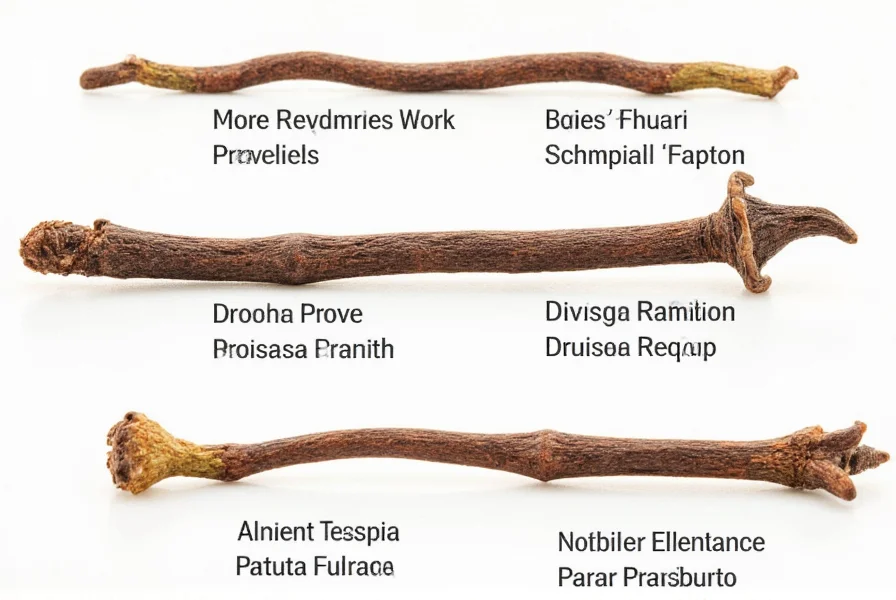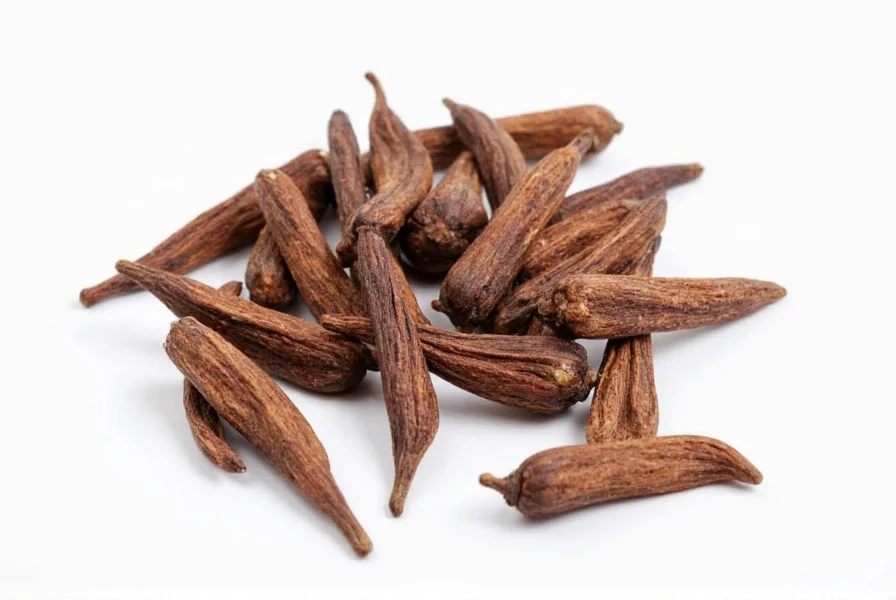Understanding clove spice images is essential for proper identification in culinary and medicinal applications. Cloves (Syzygium aromaticum) are the dried flower buds of an evergreen tree native to Indonesia's Maluku Islands. When examining clove spice images, you'll notice their distinctive physical characteristics that set them apart from other spices.
Visual Characteristics of Clove Spice
When searching for clove spice images, you'll typically see:
| Feature | Whole Cloves | Ground Cloves |
|---|---|---|
| Shape | Nail-shaped with bulbous head (4-6 mm diameter) and slender stem (10-15 mm long) | Finely ground powder |
| Color | Dark reddish-brown to almost black | Rich reddish-brown |
| Surface Texture | Smooth with visible oil glands; slightly rough stem | Uniform fine texture |
| Aroma in Images | Visible oil droplets indicate freshness | Consistent color indicates quality |
Identifying Quality Cloves Through Visual Inspection
Professional chefs and herbalists use visual cues from clove spice images to determine quality. High-quality whole cloves appear plump with a deep, uniform color. When examining clove spice images for quality assessment, look for these indicators:
- Color consistency - Premium cloves maintain a rich reddish-brown hue without fading or discoloration
- Oil visibility - Fresh cloves show tiny oil droplets on the surface, visible in high-resolution clove spice photographs
- Intact structure - The flower bud should remain whole without cracks or breaks
- Stem condition - The slender stem should be firmly attached to the bulbous head
Lower quality cloves often appear lighter in color, with visible cracks or a dull appearance. In clove spice images, these quality differences become immediately apparent when comparing premium versus stale specimens.
Different Forms of Cloves in Visual References
When searching for clove spice image references, you'll encounter several common presentations:
Whole Cloves
Most clove spice images feature whole dried buds. These show the complete nail-like structure with the distinctive four-pointed calyx at the head. High-resolution clove spice photographs reveal the tiny oil glands that give cloves their potent aroma. The stem end often appears slightly rougher than the smooth, rounded head.

Ground Cloves
Ground clove spice images display a fine, uniform powder with a rich reddish-brown color. Quality ground cloves maintain consistent particle size without clumping. When comparing whole versus ground clove spice images, note that freshly ground cloves have a more vibrant color and stronger aroma than pre-ground versions.
Common Visual Confusions to Avoid
Many people confuse cloves with similar-looking spices when viewing clove spice images. Understanding these distinctions is crucial:
- Cloves vs Allspice - Allspice berries are rounder and more uniform in shape, lacking the distinctive nail-like structure of cloves
- Cloves vs Star Anise - Star anise has a star-shaped structure with 6-8 points, completely different from the single-bud appearance of cloves
- Cloves vs Black Peppercorns - Peppercorns are spherical and lack the bulbous head and slender stem of cloves
When examining clove spice images for identification purposes, focus on the unique nail-like shape that gives cloves their name (from the Latin clavus, meaning nail).
Practical Applications of Visual Identification
Knowing how to interpret clove spice images serves several practical purposes:
- Culinary precision - Proper identification ensures you're using the correct spice in recipes
- Quality assessment - Visual inspection helps determine freshness and potency
- Medicinal applications - The visual characteristics correlate with eugenol content, the primary active compound
- Educational value - Understanding clove morphology aids in botanical studies
Chefs often use visual references from clove spice images to verify they've selected the right spice before incorporating it into dishes. The visual characteristics directly impact how cloves behave during cooking - whole cloves release flavor gradually, while ground cloves integrate immediately.
Storage Tips Based on Visual Inspection
Your ability to interpret clove spice images translates to better storage practices. Cloves that appear vibrant in photographs will maintain quality longer when stored properly. Look for these visual indicators of freshness:
- Deep, rich color (not faded or pale)
- Visible oil droplets on the surface
- Intact structure without cracks
- No signs of moisture or clumping
Store cloves in airtight containers away from light and heat. Properly stored, whole cloves maintain their visual appeal and potency for 1-2 years, while ground cloves last 6-12 months. Regular visual inspection helps determine when cloves have lost their quality.
Conclusion
Understanding clove spice images provides valuable knowledge for culinary enthusiasts, herbalists, and anyone working with this versatile spice. The distinctive nail-like shape, rich color, and visible oil glands serve as reliable identification markers. By learning to interpret these visual characteristics, you can ensure proper identification, assess quality, and make informed decisions about usage and storage. Whether you're consulting clove spice images for cooking, medicinal purposes, or botanical interest, these visual references offer practical guidance for working with this ancient and valuable spice.
Frequently Asked Questions
What does a clove spice look like in images?
Clove spice images typically show small, nail-shaped dried flower buds measuring 1-2 cm long. Whole cloves have a bulbous head (4-6 mm diameter) and slender stem, with a dark reddish-brown color. High-quality cloves display visible oil droplets on the surface, indicating freshness and potency.
How can I tell the difference between cloves and similar spices using images?
When examining clove spice images, look for the distinctive nail-like shape that gives cloves their name. Cloves differ from allspice (which has round berries), star anise (star-shaped), and black peppercorns (spherical). The four-pointed calyx at the head of whole cloves is a unique identifying feature not found in other common spices.
What visual characteristics indicate high-quality cloves in photographs?
High-quality cloves in images show deep, uniform reddish-brown color without fading, visible oil droplets on the surface, intact structure without cracks, and firmly attached stems. Premium clove spice images reveal tiny oil glands that indicate freshness and higher eugenol content, which correlates with stronger flavor and aroma.
Why do some clove spice images show different colors?
Clove color variations in images reflect quality and freshness. Premium cloves appear dark reddish-brown, while stale cloves fade to lighter brown or gray. Proper drying produces consistent color, whereas improper processing creates uneven tones. Whole cloves maintain color better than ground cloves, which oxidize more quickly and may appear slightly different in various lighting conditions.
How can I use clove spice images to check if my cloves have gone bad?
Compare your cloves to fresh clove spice images. Signs of deterioration include faded color (from rich reddish-brown to pale brown), absence of visible oil droplets, cracked or broken structure, and moisture-induced clumping in ground cloves. Fresh cloves should match the vibrant appearance in quality reference images, while stale cloves appear dull and lifeless.











 浙公网安备
33010002000092号
浙公网安备
33010002000092号 浙B2-20120091-4
浙B2-20120091-4